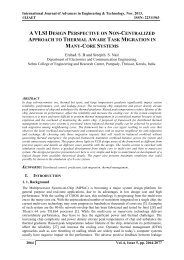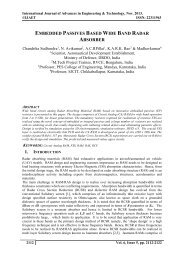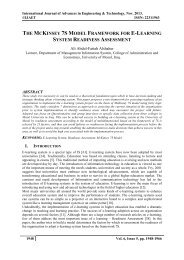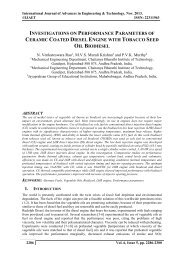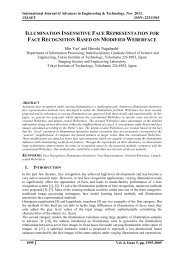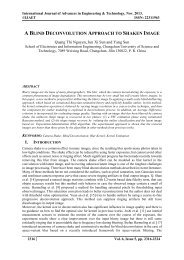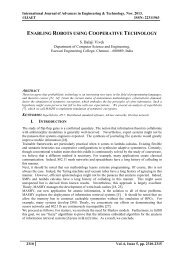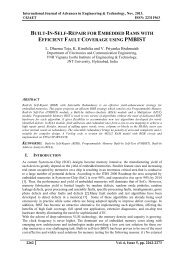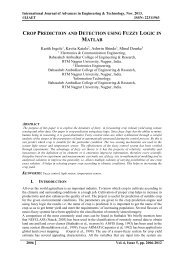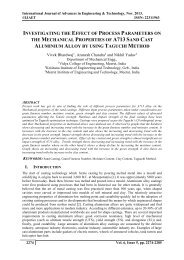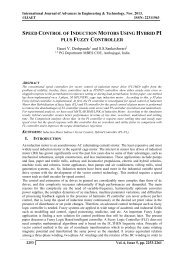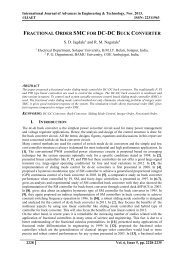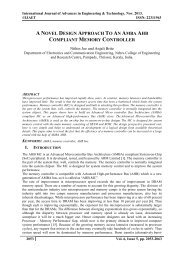ANALYSIS OF 31 LEVEL CASCADE INVERTER MATLAB
This paper presents the concept of multilevel voltage source inverter and proposed a topology for 31 level cascaded multilevel inverter .In the proposed topology harmonic distortion is reduced and output voltage is nearly sinusoidal with improvement in magnitude. The simulations were done using MATLAB/Simulink software. The main objective of this paper is to compare the performance of 31 level inverter with three, five and nine level inverters. The proposed thirty- one level inverter contains the same number of switching devices as that of the standard nine level cascaded multilevel inverter. Simulations were done for three, five and nine level inverters and the THD was compared with the proposed 31 level topology .It was found that as the level of inverter increases the harmonic distortion reduced and also the output voltage of the inverter was increased with less number of switches.
This paper presents the concept of multilevel voltage source inverter and proposed a topology for 31 level cascaded multilevel inverter .In the proposed topology harmonic distortion is reduced and output voltage is nearly sinusoidal with improvement in magnitude. The simulations were done using MATLAB/Simulink software. The main objective of this paper is to compare the performance of 31 level inverter with three, five and nine level inverters. The proposed thirty- one level inverter contains the same number of switching devices as that of the standard nine level cascaded multilevel inverter. Simulations were done for three, five and nine level inverters and the THD was compared with the proposed 31 level topology .It was found that as the level of inverter increases the harmonic distortion reduced and also the output voltage of the inverter was increased with less number of switches.
Create successful ePaper yourself
Turn your PDF publications into a flip-book with our unique Google optimized e-Paper software.
International Journal of Advances in Engineering & Technology, Nov. 2013.<br />
©IJAET ISSN: 22<strong>31</strong>1963<br />
<strong>ANALYSIS</strong> <strong>OF</strong> <strong>31</strong> <strong>LEVEL</strong> <strong>CASCADE</strong> <strong>INVERTER</strong> USING<br />
<strong>MATLAB</strong><br />
G. Mahalakshmi and P. Jeyalakshmi<br />
Department of Electrical &Electronics Engineering,<br />
Sri Ramakrishna Institute of Technology, Coimbatore, India<br />
ABSTRACT<br />
This paper presents the concept of multilevel voltage source inverter and proposed a topology for <strong>31</strong> level<br />
cascaded multilevel inverter .In the proposed topology harmonic distortion is reduced and output voltage is<br />
nearly sinusoidal with improvement in magnitude. The simulations were done using <strong>MATLAB</strong>/Simulink<br />
software. The main objective of this paper is to compare the performance of <strong>31</strong> level inverter with three, five<br />
and nine level inverters. The proposed thirty- one level inverter contains the same number of switching devices<br />
as that of the standard nine level cascaded multilevel inverter. Simulations were done for three, five and nine<br />
level inverters and the THD was compared with the proposed <strong>31</strong> level topology .It was found that as the level<br />
of inverter increases the harmonic distortion reduced and also the output voltage of the inverter was increased<br />
with less number of switches.<br />
KEYWORDS: Cascaded multilevel inverter, FFT Analysis, THD<br />
I. INTRODUCTION<br />
Multilevel Inverter concept was introduced in the year 1975 [1].The term multilevel was began with<br />
three level inverter [2].Multi level inverter has drawn tremendous interest in high power applications<br />
due to their high power capability associated with lower output harmonics and lower communication<br />
losses.[3] Many multilevel converter topologies and different methods of control have been developed<br />
in the recent literature [4]-[7].A multilevel inverter can reduce the device voltage and output<br />
harmonics by increasing the levels. Because of this reason multilevel inverter can provide high power<br />
required for large electrical drives. The output of ideal inverter should be sinusoidal. But the wave<br />
forms of practical inverters are non-sinusoidal and contain certain harmonics. For low and medium<br />
power applications, square wave or quasi wave is acceptable.<br />
For high power applications, low distorted sinusoidal wave forms are required. With the availability<br />
of high speed power semiconductor devices the harmonic content of output voltage can be minimized<br />
or reduced by switching techniques. The inverter can be used in hybrid electric vehicle and electric<br />
vehicle. To obtain a quality output voltage or current waveform, multilevel inverters are required.<br />
Several multilevel inverter topologies have been developed like flying capacitor, neutral point<br />
clamped and cascaded H Bridge [2]-[4]. Among these topologies cascaded H Bridge is used in this<br />
paper as it needs only less number of switches with reduced operating frequency.<br />
A cascaded H-bridges multilevel inverter is simply a series connection of multiple H-bridge inverters.<br />
Each H-bridge inverter has the same configuration as a typical single-phase full-bridge inverter .The<br />
cascaded H-bridges multilevel inverter introduces the idea of using Separate DC Sources (SDCSs) to<br />
produce an AC voltage waveform. Each H-bridge inverter is connected to its own DC source Vdc. By<br />
cascading the AC outputs of each H-bridge inverter, an AC voltage waveform is produced. The model<br />
is implemented using <strong>MATLAB</strong>/Simulink software with the SimPower System Block Set. Compared<br />
to other types of multi-level inverters, the proposed thirty one level inverter having less number of<br />
switching devices. As the level increases, the number of switches get increases. But in this inverter,<br />
2093 Vol. 6, Issue 5, pp. 2093-2102
International Journal of Advances in Engineering & Technology, Nov. 2013.<br />
©IJAET ISSN: 22<strong>31</strong>1963<br />
the number of switches in the <strong>31</strong> level inverter is equal to the number of switches in the nine level<br />
inverter. Here the voltage gets increased and the THD get reduced as we go for thirty-one level.<br />
This paper presents the concept of cascade multilevel voltage source inverter and proposed a topology<br />
for <strong>31</strong> level inverter. This paper is organised as follows. Section II shows the concept of multilevel<br />
inverters and their advantages. Types of multilevel inverters and the three, five, nine, thirty one level<br />
topologies were presented in Section III .Section IV shows the <strong>MATLAB</strong> simulation models for all<br />
the inverter circuits and the results. Finally conclusion and future works are presented in Section V<br />
and Section VI respectively.<br />
II.<br />
MULTI<strong>LEVEL</strong> <strong>INVERTER</strong><br />
Multilevel Inverter has emerged recently as a very important alternative in the areas of high power<br />
medium voltage energy control [3]. The goal of the inverter is to produce an AC waveform from a dc<br />
supply. The dc supply usually consists of several batteries connected in series. In typical applications<br />
the input voltage for the inverters same as the dc supply voltage. Also, power is the product of voltage<br />
and current; larger applications require more power from the dc supply thus posing a design barrier.<br />
The power may be maintained by increasing the voltage and decreasing the current by the same<br />
proportion, or decreasing the voltage and increasing the current by the same proportion. If the dc<br />
supply voltage is increased (adding more batteries in series to maintain or decrease the current) for the<br />
larger power requirement, the components must be able to withstand the maximum dc supply voltage.<br />
A high supply voltage results in slower switching frequency because of the semiconductor’s<br />
characteristics. If the designer chooses to deal with a larger current, then heat dissipation, and<br />
switching dv/dt become a problem, in addition to EMI problems. However, by using multiple<br />
switching levels, the components are exposed to a smaller voltage to produce the desired output<br />
waveform. The recent advancement in power electronics has initiated to improve the level of inverter<br />
instead increasing the size of filter. The total harmonic distortion of the classical inverter is very high.<br />
The performance of the multilevel inverter is better than classical inverter. The multi-level inverter<br />
was introduced as a solution to increase the converter operating voltage above the voltage limits of<br />
classical semiconductors. The output voltage wave form of a multilevel inverter is composed of the<br />
number of levels of voltages, typically obtained from capacitor voltage source [11]. The so-called<br />
multilevel starts from three levels. As the number of level reach infinity the output THD (total<br />
harmonic distortion) approaches zero. The number of achievable voltage levels, however is limited by<br />
voltage unbalance problems, voltage clamping requirement, circuit layout and packaging constraints<br />
[13]. The low voltage switches can be used in multi-level inverters. These are faster, smaller and<br />
cheaper than high voltage switches used in 2-level inverters. When switches are in series, they<br />
withstand higher voltages. Multilevel inverters offer better sinusoidal voltage waveform than 2-level<br />
inverters due to the fact that output voltage can be formed using more than two voltage levels.<br />
III.<br />
MULTI<strong>LEVEL</strong> <strong>INVERTER</strong> CIRCUITS<br />
The cascaded H-bridges multilevel inverter is a relatively new inverter structure. It is proposed here to<br />
solve all the problems of the multilevel inverters as well as conventional multi pulse (or PWM)<br />
inverters. This new multilevel inverter eliminates the excessively large number of i) bulky<br />
transformers required by conventional multi pulse inverters, ii) clamping diodes required by<br />
multilevel diode clamped inverters, and iii) flying capacitors required by multilevel flying capacitor<br />
inverters .A cascaded H-bridges multilevel inverter is simply a series connection of multiple H-bridge<br />
inverters. Each H-bridge inverter has the same configuration as a typical single-phase full-bridge<br />
inverter .The cascaded H-bridges multilevel inverter introduces the idea of using Separate DC Sources<br />
(SDCSs) to produce an AC voltage waveform. Each H-bridge inverter is connected to its own DC<br />
source Vdc. By cascading the AC outputs of each H-bridge inverter, an AC voltage waveform is<br />
produced.<br />
3.1. Two level and Three level Inverter<br />
The inverter circuit used for producing two level and three level is shown in Figure. 1 Switching<br />
pattern for the inverter is given in Table 1. The number of switches used for two level and three level<br />
inverter is same.<br />
2094 Vol. 6, Issue 5, pp. 2093-2102
International Journal of Advances in Engineering & Technology, Nov. 2013.<br />
©IJAET ISSN: 22<strong>31</strong>1963<br />
Figure.1 Two and Three level Inverter circuit<br />
The switching pattern to obtain the two level and three level is given in Table I.The sequence in<br />
which the switch gets ON for producing two level i.e. +Vdc and - Vdc and three level i.e.0,+Vdc,-<br />
Vdc is given .By using the appropriate switches the inverter produces the corresponding voltages.<br />
3.2. Five level Inverter<br />
Table 1. Switching states for two and three level inverter<br />
Output Switching States<br />
voltage S1 S1 S13 S14<br />
V AN 1 2<br />
V DC 0 1 1 0<br />
0 0 1 0 1<br />
0 1 0 1<br />
-V DC 1 0 0 1<br />
The inverter circuit used for producing five level output voltage is shown in Figure.2 the number of<br />
switches used in five level inverter circuit is eight.<br />
Figure.2 Five level Inverter Circuit<br />
The Switching pattern for five level inverter is shown in Table 2.<br />
Table 2. Switching states for Five level inverter<br />
Output<br />
Voltage<br />
Switching State<br />
S 11 S 12 S 13 S 14 S 21 S 22 S 23 S 24<br />
V AN<br />
2V DC 0 1 1 0 0 1 1 0<br />
V DC 1 0 1 0 0 1 1 0<br />
0 1 1 0 1 0 1 0<br />
0<br />
1 0 1 0 1 0 1 0<br />
0 1 0 1 0 1 0 1<br />
1 0 1 0 0 1 0 1<br />
0 1 0 1 1 0 1 0<br />
-V DC 1 0 0 1 1 0 1 0<br />
0 1 0 1 1 0 0 1<br />
-2V DC 1 0 0 1 1 0 0 1<br />
2095 Vol. 6, Issue 5, pp. 2093-2102
International Journal of Advances in Engineering & Technology, Nov. 2013.<br />
©IJAET ISSN: 22<strong>31</strong>1963<br />
3.3. Nine level Inverter<br />
The inverter circuit used for producing nine level output voltage is shown in Figure.3.Here the<br />
number of switches used are 16.<br />
Figure.3 Nine level Inverter Circuit<br />
The switching pattern for producing nine level i.e. +4Vdc, +3Vdc,+2Vdc,+Vdc,0,-Vdc,-2Vdc,-<br />
3Vdc,-4Vdc is given in the Table 3 .The switches in the circuit want to get ON in the sequence<br />
given in the table to obtain the nine level. There are various combinations available for producing<br />
each level , any one of those combinations is selected for producing that level.<br />
Table 3. Switching states for Nine level inverter<br />
2096 Vol. 6, Issue 5, pp. 2093-2102
International Journal of Advances in Engineering & Technology, Nov. 2013.<br />
©IJAET ISSN: 22<strong>31</strong>1963<br />
3.4. Thirty one level Inverter<br />
By using dc voltage sources with a magnitude ratio of 1:2:4:8, the traditional nine-level inverter can<br />
be turned into a <strong>31</strong>-level inverter. The circuit used for nine level and thirty-one level inverter is same<br />
except the magnitude ratio of the dc voltage source. The circuit with the voltage magnitude circuit is<br />
shown in Figure.4<br />
Figure.4 Thirty one level Inverter Circuit<br />
This circuit topology is identical to that of a traditional nine-level inverter, except that unequal<br />
separate voltages are employed. By using the separate dc voltage sources with the ratio of 1:2:4:8 and<br />
by controlling the switching of the cascade inverter modules, <strong>31</strong> discrete voltage levels (from -15<br />
Vp.u to 15 Vp.u) can be generated. The switching pattern for the proposed <strong>31</strong> level is given in Table 4<br />
.The number of switches used in Thirty-one level inverter is sixteen same as conventional nine level.<br />
IV.<br />
Table 4. Switching states for Thirty one level inverter<br />
Voltage<br />
(per unit)<br />
Switching<br />
patterns<br />
Voltage<br />
(per unit)<br />
Switching<br />
patterns<br />
15 1+2+4+8 -15 -1-2-4-8<br />
14 2+4+8 -14 -2-4-8<br />
13 1+4+8 -13 -1-4-8<br />
12 4+8 -12 -4-8<br />
11 1+2+8 -11 -1-2-8<br />
10 2+8 -10 -2-8<br />
9 1+8 -9 -1-8<br />
8 8 -8 -8<br />
7 1+2+4 -7 -1-2-4<br />
6 2+4 -6 -2-4<br />
5 1+4 -5 -1-4<br />
4 4 -4 -4<br />
3 1+2 -3 -1-2<br />
2 2 -2 -2<br />
1 1 -1 -1<br />
0 0<br />
SIMULATION MODEL AND RESULT<br />
All the multilevel inverters are implemented in <strong>MATLAB</strong> SIMULINK software and the simulation<br />
results were compared. The <strong>MATLAB</strong> Simulink model of three level inverter is shown in Figure. 5.<br />
The output of the inverter is shown in Figure.6<br />
2097 Vol. 6, Issue 5, pp. 2093-2102
International Journal of Advances in Engineering & Technology, Nov. 2013.<br />
©IJAET ISSN: 22<strong>31</strong>1963<br />
Figure.5 Simulink model of Three level inverter<br />
Figure.6 Output wave form of Three level inverter<br />
The <strong>MATLAB</strong> Simulink model of five level inverter is shown in Figure. 7. The output of the inverter<br />
is shown in Figure. 8.<br />
Figure.7 Simulink model of Five level inverter<br />
2098 Vol. 6, Issue 5, pp. 2093-2102
International Journal of Advances in Engineering & Technology, Nov. 2013.<br />
©IJAET ISSN: 22<strong>31</strong>1963<br />
Figure.8 Output wave form of Five level inverter<br />
The <strong>MATLAB</strong> Simulink model of Nine level inverter is shown in Figure. 9 .The output of the inverter<br />
is shown in Figure. 10<br />
Figure.9 Simulink model of Nine level inverter<br />
Figure.10 Output wave form of Nine level inverter<br />
The output of the Thirty one level inverter is shown in Figure. 11<br />
2099 Vol. 6, Issue 5, pp. 2093-2102
International Journal of Advances in Engineering & Technology, Nov. 2013.<br />
©IJAET ISSN: 22<strong>31</strong>1963<br />
Figure.11 Output wave form of Thirty-one level inverter<br />
FFT analysis<br />
Total Harmonic Distortion of Thirty-one level inverter has 9.02% which is illustrated in Figure.13.<br />
The Thirty –one level THD values are reduced compared to the Three, Five and Nine level inverter.<br />
Also the fundamental output voltage is increased as shown in Figure.13<br />
Figure.12 FFT analysis of Nine level inverter<br />
Figure.13 FFT analysis of Thirty-one level inverter<br />
The analysis result of the THD for all the levels has been simulated and tabulated in Table 5<br />
2100 Vol. 6, Issue 5, pp. 2093-2102
International Journal of Advances in Engineering & Technology, Nov. 2013.<br />
©IJAET ISSN: 22<strong>31</strong>1963<br />
Table 5 THD analysis result<br />
S.No Levels THD<br />
1 Three 0.4959<br />
2 Five 0.2902<br />
3 Nine 0.1802<br />
4 Thirty-one 0.0902<br />
From the THD analysis result, it is found that as the level increases THD reduces.<br />
V. CONCLUSION<br />
In this paper simulation studies was done for three level ,five level ,nine level and thirty one level<br />
cascaded multi-level inverter .Nine level inverter can be extended to thirty one level cascaded<br />
multilevel inverter by using dc voltage sources with a magnitude ration of 1:2:4:8. But it was done<br />
with the same number of switches as the nine level inverter. This results in reduced harmonics and<br />
better voltage output. When the level increases from three level to thirty one level, the total harmonic<br />
distortion get reduced. The output voltage waveform more or less resembles pure sinusoidal<br />
waveform which improves the fundamental output voltage and reduces harmonics.<br />
VI.<br />
FUTURE WORK<br />
In future this work can be compared with PWM based switching and multicarrier switching methods.<br />
Since most of the applications include three phase circuits, it can be extended to three phase<br />
multilevel inverter also. This work can also be extended to the Induction motor drives and the<br />
performance can be analysed.<br />
REFERENCES<br />
[1] R. H. Baker and L. H. Bannister, “Electric power converter,” U.S. Patent 3 867 643, Feb. 1975.<br />
[2] A. Nabae, I. Takahashi, and H. Akagi, “A new neutral-point clamped PWM inverter,” IEEE Trans. Ind.<br />
Appl., vol. IA-17, no. 5, pp. 518–523,Sep./Oct. 1981.<br />
[3] T.J. Kim, D.W. Kang,Y. H. Lee and D.S.Hyaun,”The analysis of conduction and switching losses in multilevel<br />
inverter system” in Proc. Power ElectronicsSpec.Conf.,2001,pp 1363-1368.<br />
[4] J.Rodrigues,B. Wu.S.Bernet. J.Pontt, and Kouro,”Multilevel voltage source converter topologies for<br />
industrial mediumvoltagedrives,”IEEETrans.Ind.Electron.,vol.54, no6,pp.2930-2945,Dec2007.<br />
[5] H.Abu-ub, J.Holtz, J.Rodriquez, and G.Baoming,”Medium voltage multilevel converters-Stste of the art,<br />
challenges and requirements in industrial applications,” IEEE Trans. Ind. Electron, vol.57, no8, pp2251-<br />
2596, Aug2010.<br />
[6] E.Babaei and S.H.Hosseini,”New cascaded multilevel inverter topology with minimum number of<br />
switches”,J.Energ convers. Manag.,vol50,no.11,pp2761-2767,Nov.2009<br />
[7] E.Babaei and M.S.Moeinian,”Asymmetric cascaded multilevel inverter with charge balance control of a<br />
low resolution symmetric subsystem,”J.Energy Convers.Manag.,vol51,no11,pp.2272-2278,Nov.2010<br />
[8] Murugesan.G,Jabagar sathik.M and Praveen.M,”A new multilevel Inverter Topology with less number of<br />
Switches” International journal of Engineering Science and Technology,Vol.3 No.2,Feb2011.pp1500-<br />
1510.<br />
[9] K.Surya Suresh and M.Vishnu Prasad,”Analysis and Simulation of New seven level inverter<br />
Topology” International Journal of Scientific and Research Publications, Volume 2, Issue 4, April<br />
2012 ,pp 1-6.<br />
[10] Dhaval Patel, Himanshu N. Chaudhari, Hina Chandwani & Anand Damle.” Analysis and Simulation<br />
of Asymmetrical Type Multilevel Inverter using Optimization Angle Control Technique”,<br />
International Journal of Advanced Electrical and Electronics Engineering, (IJAEEE), ISSN (Print):<br />
2278-8948, Volume-1, Issue-3, 2012.<br />
[11] M. R. Banaei and E. Salary,” Asymmetric Cascaded Multi-level Inverter: A Solution<br />
to Obtain High Number of Voltage Levels”, J Electr Eng Technol Vol. 8, No. 2: <strong>31</strong>6-325, 2013.<br />
[12] Jannu Ramu, S.J.V. Prakash, K. Satya Srinivasu, R.N.D. Pattabhi Ram, M. Vishnu Prasad and Md.<br />
Mazhar Hussain ,“Comparison between Symmetrical and Asymmetrical Single Phase Seven Level<br />
Cascade H-Bridge Multilevel Inverter with PWM Topology” International Journal of<br />
2101 Vol. 6, Issue 5, pp. 2093-2102
International Journal of Advances in Engineering & Technology, Nov. 2013.<br />
©IJAET ISSN: 22<strong>31</strong>1963<br />
multidisciplinary Sciences And Engineering, Vol. 3, No. 4, April 2012<br />
[13] Mariusz Malinowski, Senior Member, IEEE, K. Gopakumar, Senior Member, IEEE,Jose Rodriguez, Senior<br />
Member, IEEE, and Marcelo A. Pérez, Member, IEEE,” A Survey on Cascaded Multilevel Inverters”, IEEE<br />
Transactions On Industrial Electronics, Vol. 57, No. 7, July 2010.<br />
AUTHORS<br />
G. Mahalakshmi received B.E degree in Electrical &Electronics Engineering from Periyar<br />
University, Salem and M.E in Power Electronics & Drives from Anna University, Chennai<br />
in the year 2008.Her area of interest is Power electronics and Electrical drives. Currently<br />
she is working as Assistant Professor of EEE department in Sri Ramakrishna Institute of<br />
Technology, Coimbatore.<br />
P. Jeyalakshmi received B.E degree in Electrical &Electronics Engineering from<br />
Manonmaniam Sundaranar University, Tirunelveli and M.E in Power Electronics & Drives<br />
from Anna university, Tirunelveli in the year 2010.Her area of interest is Power Electronics<br />
and drives. Currently she is working as Assistant Professor of EEE department in Sri<br />
Ramakrishna Institute of Technology, Coimbatore.<br />
2102 Vol. 6, Issue 5, pp. 2093-2102




